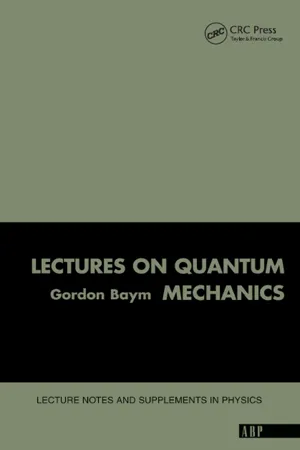Physics
Delta Function Potential
The delta function potential is a concept in quantum mechanics that represents a potential energy function as a Dirac delta function. It is often used to model interactions in quantum systems, such as the potential energy experienced by a particle in the vicinity of a localized impurity or barrier. The delta function potential is a key tool for understanding quantum mechanical behavior in various physical systems.
Written by Perlego with AI-assistance
Related key terms
Related key terms
1 of 4
Related key terms
1 of 3
5 Key excerpts on "Delta Function Potential"
- eBook - ePub
- Gordon Baym(Author)
- 2018(Publication Date)
- CRC Press(Publisher)
The extent to which the well distorts the incoming wave packet in transmitting it depends on how much the well changes the relative phases of the components of the incoming packet. The faster δ(E) varies the greater the change in the relative phases. 5 ONE-DIMENSIONAL Delta Function Potential As a special example of transmission by a potential let us consider a Delta Function Potential in one dimension v (x) = v 0 δ (x). (4-88) v 0 has dimensions of energy times length. The Schrödinger equation is (E + ħ 2 2 m d 2 dx 2) ψ (x) = v 0 δ (x) ψ (x) = v 0 δ (x) ψ (0), (4-89) and has a. solution ψ (x) = ψ inc (x) + ∫ − ∞ ∞ dp 2 π ħ e ipx / ħ E − p 2 / 2 m v 0 ψ (0), (4-90) where ψ inc (x) ~ e ± i 2 mE x / ħ solves the free particle Schrödinger equation. To see that (4-90) is a solution, we act on it with E + (ħ 2 /2m) (d 2 /dx 2); this annihilates Ψ inc (x) turns the second term into ∫ − ∞ ∞ dp 2 π ħ (E − p 2 / 2 m) e ipx / ħ E − p 2 / 2 m v 0 ψ (0), Fig. 4-13 Contour of integration for outgoing waves; the dotted line is the closure of the contour at infinity in the lower half-plane. which from (3-53) [in one dimension] is just v 0 ψ(0)δ(x). Now the integral in (4-90) has poles at p = ± 2 mE, and to specify completely the solution we must specify what the contour of integration does near these poles; this corresponds to choosing boundary conditions on the solution (4-90). We should like to choose the boundary condition of outgoing waves, i.e., that the integral behaves as a wave traveling to the right, for x > 0, and a wave traveling to the left, for x < 0. We therefore choose the integration contour in Fig. 4-13 ; then for x > 0 we can close the contour of integration in the upper half-plane, surrounding therefore only the pole at p = 2 mE, and find ∫ − ∞ ∞ dp 2 π ħ e ipx / ħ E − p 2 / 2 m = me i 2 mE x / ħ i ħ 2 mE, x > 0, (4-91) which is an outgoing wave - Kam Tim Chau(Author)
- 2017(Publication Date)
- CRC Press(Publisher)
8.10 DIRAC DELTA FUNCTIONFor simplicity, we first recast the definition of a Dirac delta function defined in (8.8 ) and (8.9 ) for the one-dimensional case:(8.161)δ ( x ) = 0 x ≠ 0= ∞ x = 0(8.162)∫δ∞- ∞( x )d x = 1This can be considered as a special case of the one given in (8.8 ) and (8.9 ). Another basic definition of the delta function is the shifting property of the Dirac delta function:(8.163)∫f∞- ∞( x )δ( x )d x = f( 0 )This Dirac delta function is named in honor of electrical engineer and physicist, Paul Dirac, who received the Nobel Prize in physics for his major contribution to quantum mechanics. The idea of using the Dirac delta function was actually much earlier than its usage in quantum mechanics by Dirac. For example, it can be used to prescribe point force in the case of beam bending subject to a concentrated force. Physically, in the domain ofmechanics, the delta function defined above is a point force or called a concentrated point.According to our normal understanding in mathematics, there is no function that is nonzero only at one point and yet still has a finite integral as defined in (8.162- Duangkamon Baowan, Barry J Cox, Tamsyn A Hilder, James M Hill, Ngamta Thamwattana(Authors)
- 2017(Publication Date)
- William Andrew(Publisher)
The delta function not only enables the equations to be simplified, but it also allows the motion of the baseball to be calculated by only considering the total impulse of the bat against the ball, rather than requiring the details of how the bat transferred energy to the ball. However, we note that the Dirac delta function is not strictly a function, although for many purposes it can be manipulated as such and can be formally defined as a generalised function or as a distribution that is also a measure. The Dirac delta function can be thought of as a function on the real line, which is zero everywhere except at the origin where it becomes very large, as shown in Fig. 2.1, such that Fig. 2.1 Plot of the Dirac delta function. δ (x) → ∞, x = 0 = 0, x ≠ 0, and it is constrained to satisfy the identity ∫ − ∞ ∞ δ (x) d x = 1. (2.1) This definition gives an intuitive grasp of the Dirac delta function but should not be taken too seriously because no normal function has the above properties. Moreover, there exist descriptions of the delta function which differ from the above conceptualisation. Formally, we define a delta function as a limit of a delta convergent sequence. For example, one such delta convergent sequence is the Lorentz–Cauchy functions, given by F ϵ (x) = 1 π ϵ x 2 + ϵ 2, (2.2) which satisfies the property that ∫ − ∞ ∞ F ϵ (x) d x = 1, for all ϵ > 0 and is said to converge to the delta function in the limit ϵ → ∞ ; that is lim ϵ → 0 F ϵ (x) → δ (x). Worked Example 2.1 Another delta convergent sequence is the Gaussian functions, defined. by F α (x) = 1 2 π α e − x 2 / 4 α. Show that the Gaussian functions satisfy the properties of a delta convergent sequence as α → 0- eBook - ePub
- Andre Moliton(Author)
- 2013(Publication Date)
- Wiley-ISTE(Publisher)
Chapter 2The Free Electron and State Density Functions
2.1. Overview of the free electron2.1.1. The model
As detailed in Chapter 1 , the potential (V) (rigorously termed the potential energy) for a free electron (within the zero order approximation for solid-state electronics) is that of a flat-bottomed basin, as shown by the horizontal line in the 1D model of Figure 2.1 . It can also be described by V = V 0 = 0.For a free electron placed in a potential V 0 = 0 with an electronic state described by its proper function with energy and amplitude denoted by E 0 and Ψ 0 , respectively, the Schrödinger equation for amplitude is:[2.1]2.1.2. Parameters to be determined: state density functions in k or energy spaces
With:[2.2]equation [2.1] can be written as:[2.3]Figure 2.1.(a) Symmetric wells of infinite depth (with the origin taken at the center of the wells); and (b) asymmetric wells with the origin taken at the well’s extremity (when 0 < x < L, we have V(x) = 0 so that V(- x) =∞ for a 1D model)We shall now determine for different depth potential wells, with both symmetric and asymmetric forms, the corresponding solutions for the wave function (Ψ0 ) and 0 the energy (E 0 ). To each wave function there is a corresponding electronic state (characterized by quantum numbers). It is important in physical electronics to understand the way in which these states determine how energy levels are filled.In solid-state physics, the state density function (also called the density of states) is particularly important. It can be calculated in the wave number (k ) space or in the energies (E ) space. In both cases, it is a function that is directly related to a dimension of space, so that it can be evaluated with respect to L = 1 (or V = L 3 = 1 for a 3D system). In k space, the state density function [n (k )] is such that in one dimension n (k ) dk represents the number of states placed in the interval dk (i.e. between k and k + dk in k wave number space). In 3D, n (k ) d 3 k represents the number of states placed within the elementary volume d 3 k in k - eBook - ePub
- Nandita Rudra(Author)
- 2019(Publication Date)
- CRC Press(Publisher)
Once either of the matrices are worked out as a function of energy, all problems relating to the potential barrier have essentially been solved. For example, the transmission coefficien This given by | F | 2 | A | 2 if G = 0, and therefore T = 1 | M 11 | 2 = | S 21 | 2. (6.72) This work is in its most elementary form of the S -matrix theory of the more sophisticated scattering matrix theory of collisions. 6.4 Delta Function Potential Consider a particle of mass m moving in an attractive δ -function potential V (x) = − g δ (x), (6.73) where g is a real positive constant. Integrating Eq. (6.73) one can verify that g has the dimension of energy × length, or equivalently it is square of the electrostatic charge. Though this is not a physical potential, but it serves as a useful toy model and is known as one dimensional hydrogen atom. The Schrödinger equation for this potential is − ℏ 2 2 m d 2 ψ (x) d x 2 − g δ (x) ψ (x) = E ψ (x). (6.74) Integrating Eq. (6.74) from − ∈ to + ∈, and taking the limit ∈ → 0, we get lim ε → 0 [ (d ψ d x) x = + ε − (d ψ d x) x = − ε ] + 2 m ℏ 2 g ψ (0) = 0, (6.75) since ∫ − ∈ + ∈ E ψ (x) d x ≈ E ψ (0) 2 ∈ → 0, as ε → 0. This potential problem admits of. both bound and continuum solutions. Bound state solution is given when E < 0 and the equation is d 2 ψ (x) d x 2 − κ 2 ψ (x) = − 2 m ℏ 2 g δ (x) ψ (x), κ 2 = 2 m | E | ℏ 2. (6.76) Since δ(x) is zero everywhere except at x = 0, ψ(x) must. satisfy d 2 ψ (x) d x 2 − κ 2 ψ (x) = 0 everywhere except at x = 0. Assuming ψ(x) → 0 at x → ±∞, we have ψ (x) = { A e + κ x, when x < 0, B e − κ x when x > 0. (6.77) Since ψ(x) is continuous at x = 0, we have A = B, and ψ (x) = { A e + κ x, when x ≤ 0, A e − κ x when x ≥ 0. (6.78) Using Eq. (6.76) in Eq. (6.75), − 2 κ A + 2 m A g ℏ 2 = 0, or κ = m g ℏ 2 Since κ = 2 m | E | ℏ 2, we have m g ℏ 2 = 2 m | E | ℏ 2 and the allowed energy is E = − m g 2 2 ℏ 2. (6.79) Energy is thus negative and there is only one bound state which can be nor-malized as
Index pages curate the most relevant extracts from our library of academic textbooks. They’ve been created using an in-house natural language model (NLM), each adding context and meaning to key research topics.
Explore more topic indexes
Explore more topic indexes
1 of 6
Explore more topic indexes
1 of 4




